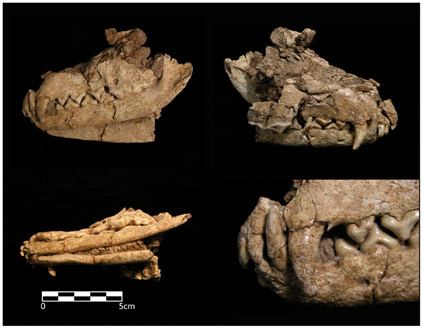A “Broken-Hearted ” Dinosaur Thescelosaurus (Unique Fossil)
Dinosaurs with Four-Chambered Hearts – Still Unproven
In April 2000, a research team published a paper on the small and relatively unremarkable American dinosaur, Thescelosaurus. However, the paper postulated that an iron concretion within the body cavity of the articulated dinosaur specimen actually represented the preserved remains of a dinosaur’s heart – the first and only time that such a fossil appertaining to Dinosauria had been found.
Thescelosaurus
The dinosaur fossils discovered in 1993 in South Dakota were purchased by the North Carolina Museum of Natural Sciences in 1996. A study of the well-preserved specimen revealed this strange object located in the body cavity where a heart might be found. The preservation of what is effectively a bag of muscle was the result of an exceptionally rare process, perhaps mineral enriched oxygen had mineralised while the specimen was in contact with groundwater, or maybe the preservation was as a result of a poorly known bacterial related process. Either way a CAT scan seemed to show that there was the remnants of a sophisticated four-chambered heart with a single systematic aorta.
At the time, this heart was regarded as being somewhere between a birds and a crocodiles in structure. This was cited as evidence that some dinosaurs had high metabolic rates – that they were endothermic (warm-blooded).
However, a re-examination of the fossil material using more powerful scanners and X-ray machines have left many palaeontologists broken-hearted. This might not have been a case of soft tissue preservation after all.
In a paper published in the scientific journal “Naturwissenschaften”, a team of palaeontologists led by Timothy Cleland of the North Carolina museum conclude that the earlier work, carried out without the use of very powerful CAT scanners and other advanced machinery was probably inaccurate.
Thescelosaurus Fossil Study
The study states:
“A three-dimensional, iron-cemented structure found in the anterior thoracic cavity [chest] of articulated Thescelosaurus skeletal remains was hypothesised to be the fossilised remains of the animal’s four-chambered heart.”
When the paper on the discovery of the “heart” was first published, over ten years ago, it sparked an intensive debate amongst scientists as to the structure and nature of the dinosaurian heart. Was the Thescelosaurus evidence proof that these animals had sophisticated and advanced hearts very similar to the heart of a mammal, even our own?
The new paper goes on to say:
“The hypothesis that this Thescelosaurus has a preserved heart was controversial, and therefore, we re-examined it using higher-resolution computed tomography [CAT scans] paleohistological examination, X-ray diffraction analysis, X-ray photoelectron spectroscopy, and scanning electron microscopy.”
This new research concludes that the object in the thoracic cavity is not a heart, but most likely a sandy concretion that formed as the organic material of the carcase rotted away.
The study concludes:
“Neither the more detailed examination of the gross morphology and orientation of the thoracic ‘heart’ nor the microstructural studies supported the hypothesis that the structure was a heart.”
With Valentines day just a fortnight away it seems that this new evidence relating to Thescelosaurus may have left one or two palaeontologists “broken-hearted”.
To view models and replicas of Late Cretaceous dinosaurs: Bullyland Prehistoric Animal Models.








